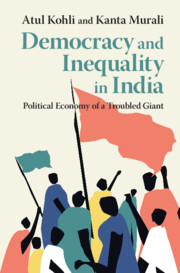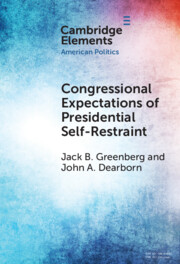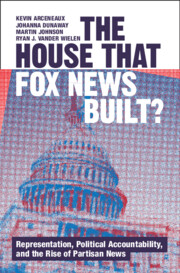Refine search
Actions for selected content:
134 results
11 - Law-Making and Incentive Bargaining
- from Part V - Legislative Policies
-
- Book:
- Incentive Bargaining and Corporate Governance
- Published online:
- 12 December 2025
- Print publication:
- 08 January 2026, pp 321-346
-
- Chapter
- Export citation
10 - The Road Ahead
-
- Book:
- Direct Hit
- Published online:
- 13 November 2025
- Print publication:
- 20 November 2025, pp 157-170
-
- Chapter
- Export citation
8 - The Turning (1971)
-
- Book:
- Waging Peace
- Published online:
- 03 November 2025
- Print publication:
- 13 November 2025, pp 328-366
-
- Chapter
- Export citation
10 - This Is Still a Democracy, Isn’t It? (1973–1975)
-
- Book:
- Waging Peace
- Published online:
- 03 November 2025
- Print publication:
- 13 November 2025, pp 394-407
-
- Chapter
- Export citation
3 - A Temporary Solution
-
- Book:
- In the Shadow of the Vatican
- Published online:
- 23 October 2025
- Print publication:
- 06 November 2025, pp 91-122
-
- Chapter
- Export citation
4 - Opportunity
-
- Book:
- Killing Machines
- Published online:
- 23 October 2025
- Print publication:
- 06 November 2025, pp 127-167
-
- Chapter
-
- You have access
- Open access
- HTML
- Export citation
2 - Means
-
- Book:
- Killing Machines
- Published online:
- 23 October 2025
- Print publication:
- 06 November 2025, pp 34-70
-
- Chapter
-
- You have access
- Open access
- HTML
- Export citation
5 - Final Controversies over the US Slave Trade, 1803–1807
-
- Book:
- Proscription by Degrees
- Published online:
- 22 December 2025
- Print publication:
- 06 November 2025, pp 189-226
-
- Chapter
- Export citation
Anti-Feminist Foreign Policy: The Impact of Abortion Politics in the United States
-
- Journal:
- Politics & Gender / Volume 21 / Issue 3 / September 2025
- Published online by Cambridge University Press:
- 05 November 2025, pp. 535-557
-
- Article
-
- You have access
- Open access
- HTML
- Export citation
1 - Democracy and Governance
- from Part I - Politics at the Apex
-
- Book:
- Democracy and Inequality in India
- Published online:
- 11 October 2025
- Print publication:
- 30 October 2025, pp 15-63
-
- Chapter
- Export citation
Introduction
-
- Book:
- Democracy and Inequality in India
- Published online:
- 11 October 2025
- Print publication:
- 30 October 2025, pp 1-12
-
- Chapter
- Export citation

Democracy and Inequality in India
- Political Economy of a Troubled Giant
-
- Published online:
- 11 October 2025
- Print publication:
- 30 October 2025
Political and Social Transformation of Kazakhstan During the Years of Revolutions
-
- Journal:
- Nationalities Papers , FirstView
- Published online by Cambridge University Press:
- 08 October 2025, pp. 1-20
-
- Article
-
- You have access
- Open access
- HTML
- Export citation
4 - The Problems of Prize
- from Part II - The Judiciary at War, 1812–1816
-
- Book:
- The Nation at Sea
- Published online:
- 28 August 2025
- Print publication:
- 11 September 2025, pp 117-152
-
- Chapter
- Export citation
Principled Pragmatism: Big Business and Campaign Contributions After January 6
-
- Journal:
- British Journal of Political Science / Volume 55 / 2025
- Published online by Cambridge University Press:
- 01 August 2025, e100
-
- Article
-
- You have access
- Open access
- HTML
- Export citation
3 - Conflicts of Interest
-
- Book:
- Spinning the World
- Published online:
- 03 July 2025
- Print publication:
- 24 July 2025, pp 62-81
-
- Chapter
- Export citation
16 - Opposition
- from Part II - Modalities
-
-
- Book:
- The Cambridge Handbook of Constitutional Theory
- Published online:
- 27 March 2025
- Print publication:
- 24 April 2025, pp 262-278
-
- Chapter
- Export citation

Congressional Expectations of Presidential Self-Restraint
-
- Published online:
- 15 April 2025
- Print publication:
- 22 May 2025
-
- Element
- Export citation
8 - Welfare, Rights, and the Market in the Post-Congress Polity, 1998–2014
- from Part III - Liberalisation and Welfare in a Multi-level Democracy
-
- Book:
- Making India Work
- Published online:
- 13 February 2025
- Print publication:
- 13 February 2025, pp 173-192
-
- Chapter
- Export citation

The House that Fox News Built?
- Representation, Political Accountability, and the Rise of Partisan News
-
- Published online:
- 06 February 2025
- Print publication:
- 13 February 2025
